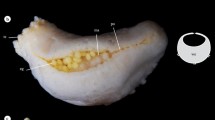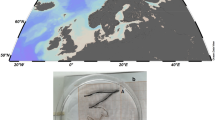Abstract
Adults of Comatilia iridometriformis, A. H. Clark, 1909, a deep-water feather star, retain the following attributes limited chiefly to juveniles of other species in its family, the Comasteridae: small size (maximum arm length about 30 mm), large radial ossicles, incomplete pinnulation, slender cirral ossicles and coarse stereom. This is the only known instance of paedomorphosis (retention of juvenile characters in the adult) among extant crinoids. Observations from the submersible “Alvin” in about 580 m indicate that C. iridometriformis lives associated with ahermatypic, bankforming corals (Lophelia prolifera and Enallopsammia profunda). The crinoids cling to dead coral and other solid substrates, but not to living coral. The crinoids appear to prefer slow, locally variable and multidirectional water movements. Although some other crinoids brood early developmental stages externally or within brood pouches, C. iridometriformis is the only crinoid that appears to brood giant embryos and larvae within the ovarian lumen (although poor histological fixation left some doubt about the exact location). Larvae approaching the cystidean stage were the most advanced brooded forms observed; release from the ovary probably occurs at about this stage. Stalked pentacrinoid larvae are sometimes found on the cirri of the adult crinoids. C. iridometriformis is also peculiar in being the only brooding member of the family Comasteridae and the only internally brooding feather star not found in middle or high southern latitudes. It is suggested that: paedomorphosis in this feather star results from accelerated sexual maturation (progenesis), the potentially unstable habitat may contribute to selection for rapid growth; and neither food nor space may be limiting. Moreover, brooding may be both a design constraint (due to small size) and a way to prevent loss of progeny from a discontinuous habitat where current flow tends to be unidirectional.
This study was carried out in 1979 on material collected chiefly in the northern Straits of Florida.
Similar content being viewed by others
Literature cited
Breimer, A.: General morphology of recent crinoids. In: Treatise on invertebrate paleontology, Part T, Echinodermata 2(1), pp T9-T58. Ed. by R. C. Moore and C. Teichert. Boulder, Colorado: Geological Society of America 1978a
Breimer, A.: Ecology of recent crinoids. In: Treatise on invertebrate paleontology, Part T, Echinodermata 2(1), pp T316-T330. Ed. by R. C. Moore and C. Teichert. Boulder, Colorado: Geological Society of America 1978b
Breimer, A.: Autecology. In: Treatise on invertebrate paleontology. Part T, Echinodermata 2 (1), pp T331-T343. Ed. by R. C. Moore and C. Teichert. Boulder, Colorado: Geological Society of America 1978c
Cairns, S. D.: The deep-water Scleractinia of the Caribbean Sea and adjacent waters. Stud. Fauna Curaçao 57, 1–341, 40 pl. (1979)
Chia, F.-S.: The embryology of a brooding starfish, Leptasterias hexactis (Stimpson). Acta Zool., Stockh. 49, 321–364 (1968)
Clark, A. H.: Comatilia, a remarkable new genus of unstalked crinoids. Proc. U.S. natn. Mus. 36, 361–367 (1909)
Clark, A. H.: A monograph of the existing crinoids. Bull. U.S. natn. Mus. 82 (1), Part 1, 1–406, 17 pl. (1915)
Clark, A. H.: A monograph of the existing crinoids. Bull. U.S. natn. Mus. 82 (1), Part 2, 1–795, 57 pl. (1921)
Clark, A. H.: A monograph of the existing crinoids. Bull. U.S. natn. Mus. 82 (1), Part 3, 1–816, 86 pl. (1931)
Clark, A. H. and A. M. Clark: A monograph of the existing crinoids. Bull. U.S. natn. Mus. 82 (1), Part 5, 1–860 (1967)
Gardiner, M. S.: The biology of invertebrates, x+954 pp. New York: McGraw-Hill Co. 1972
Gould, S. J.: Ontogeny and phylogeny, xvi+501 pp. Cambridge, Mass: Belknap Press 1977
Hendler, G.: Sex reversal and viviparity in Ophiolepis kieri n. sp., with notes on viviparous brittlestars from the Caribbean (Echinodermata: Ophiuroidea). Proc. biol. Soc. Wash. 92, 783–795 (1979)
Hyman, L. H.: The invertebrates. Vol. 4. Echinodermata, vii+763 pp. New York: McGraw-Hill Co. 1955
Ludwick, J. C. and W. Walton: Shelf-edge, calcareous prominences in the northeastern Gulf of Mexico. Bull. Am. Ass. Petrol. Geol. 41, 2054–2101 (1957)
Malloy, R. J. and R. J. Hurley: Geomorphology and geologic structure: Straits of Florida. Bull. geol. Soc. Am. 81, 1947–1972 (1970)
Menge, B. A.: Effect of wave action and competion on brooding and reproductive effort in the sea star, Leptasterias hexactis. Ecology 55, 84–93 (1974)
Messing, C. G.: The systematics and distribution of the Crinoidea Comatulida (exclusive of the Macrophreatina) collected by the R/V Gerda in the Straits of Florida and adjacent waters, 296 pp. Master's thesis, University of Miami, Florida 1975
Messing, C. G.: Reclassification and redescription of the comatulid Comatonia cristata (Hartlaub) (Echinodermata: Crinoidea). Proc. biol. Soc. Wash. 94, 240–253 (1981)
Meyer, D. L.: Length and spacing of the tube feet in crinoids (Echinodermata) and their role in suspension-feeding. Mar. Biol. 51, 361–369 (1979)
Meyer, D. L. and D. B. Macurda, Jr.: Adaptive radiation of the comatulid crinoids. Paleobiology 3, 74–82 (1977)
Meyer, D. L. and D. B. Macurda, Jr.: Ecology and distribution of the shallow water crinoids of Palau and Guam. Micronesica 16, 59–99 (1980)
Meyer, D. L., C. G. Messing and D. B. Macurda, Jr.: Zoogeography of tropical western Atlantic Crinoidea. Bull. mar. Sci. 28, 412–441 (1978)
Moore, D. R. and H. Bulliss, Jr.: A deep-water coral reef in the Gulf of Mexico. Bull. mar. Sci. Gulf Caribb. 10, 125–128 (1960)
Mortensen, T.: Studies in the development of crinoids. Pap. Dep. mar. Biol. Carnegie Instn Wash. 16, 1–94, 28 pl. (1920)
Neumann, A. C. and M. M. Ball: Submersible observations in the Straits of Florida: geology and bottom currents. Bull. geol. Soc. Am. 81, 2861–2874 (1970)
Neumann, A. C., J. W. Kofoed and G. H. Keller: Lithoherms in the Straits of Florida. Geology (Boulder, Colorado) 5, 4–10 (1977)
Pratt, R. M. and B. C. Heezen: Topography of the Blake Plateau. Deep-Sea Res. 11, 721–728 (1964)
Springer, F.: The Crinoidea Flexibilia. Text: vi+486 pp, 2 pl. Plates: 158 pp, 79 pl. Washington, D.C.: Smithsonian Institution 1920
Stearns, S. C.: Life history tactics: a review of the ideas. Q. Rev. Biol. 51, 3–47 (1976)
Stearns, S. C.: The evolution of life history traits: a critique of the theory and a review of the data. A. Rev. Ecol. Syst. 8, 145–171 (1977)
Stetson, T. R., D. F. Squires and R. M. Pratt: Coral banks occurring in deep water on the Blake Plateau. Am. Mus. Novit. 2114, 1–29 (1962)
Teichert, C.: Cold and deep water coral banks. Bull. Am. Ass. Petrol. Geol. 42, 1064–1082 (1958)
Author information
Authors and Affiliations
Additional information
Communicated by N. D. Holland, La Jolla
Rights and permissions
About this article
Cite this article
Messing, C.G. Brooding and paedomorphosis in the deep-water feather star Comatilia iridometriformis (Echinodermata: Crinoidea). Marine Biology 80, 83–91 (1984). https://doi.org/10.1007/BF00393131
Accepted:
Issue Date:
DOI: https://doi.org/10.1007/BF00393131




